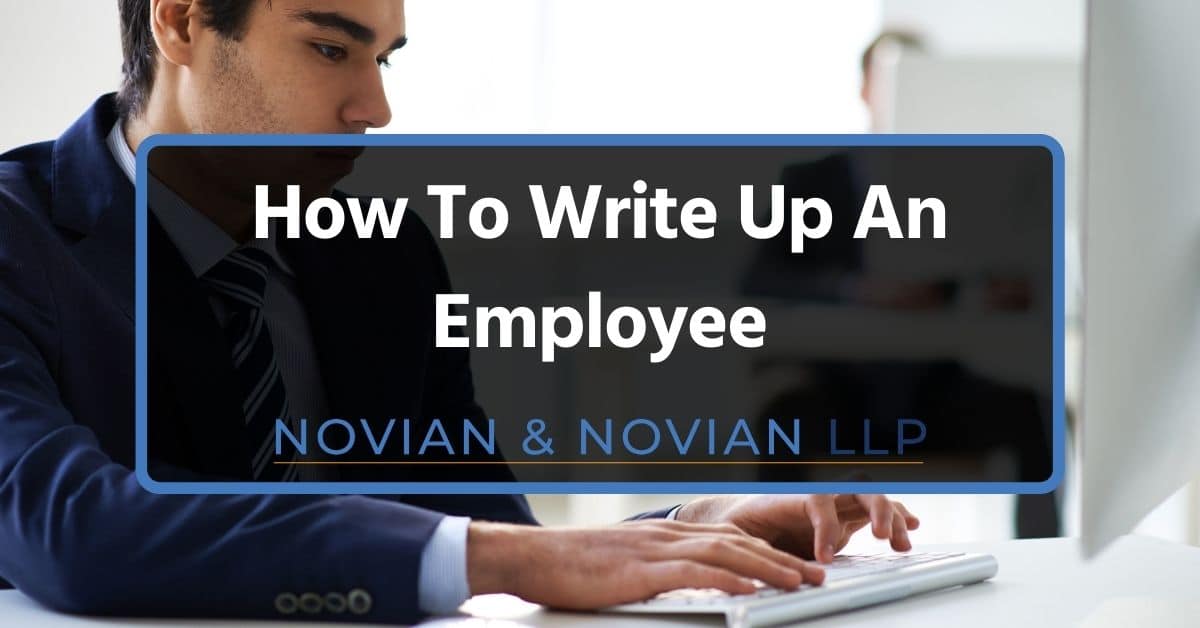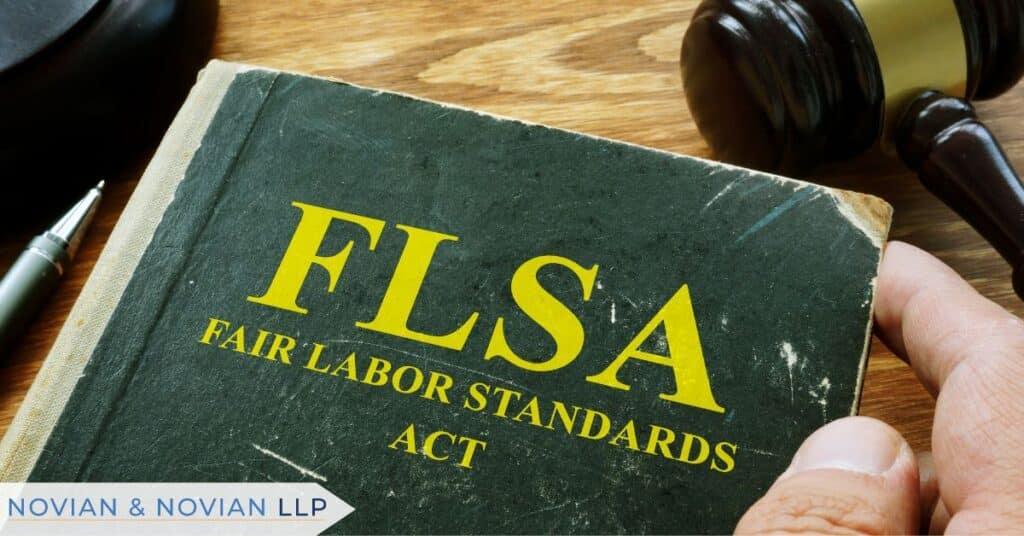
by | Feb 15, 2024 | Employment Law
With over 35 years of experience as a law firm, Novian & Novian can be your guide in the field of employment law. This guide provides general information to help professionals and employers ensure compliance with applicable laws and regulations.
An employee write-up is a formal notice that documents any employee’s behavior or performance issue within a workplace. It serves as the first formal step in the disciplinary process. It acts as a tool for effective management and legal compliance within the workplace. Employee write-ups provide a written record that can be referred to in future reference, ensuring that both the employee and the employer have a clear understanding of the expectations and the consequences outlined.
At Novian & Novian, our goal is to assist employers with a road map to follow as it relates to employment law., real estate, technology & social media intellectual property, etc.
With over 35 years of experience in the industry, you can trust us to handle your legal affairs. Reach out to us today!
This guide was written to assist employers in navigating the complexities of legally compliant and fair employee discipline through the best processes for creating a positive work environment that is legally compliant. We will also highlight consequences bound to happen if the process of writing up an employee is not properly executed.
Legal Foundations of Employee Write-Ups – Employee Rights
An employee write-up is a fundamental component of the disciplinary process in the workplace, serving as a formal notice to employees about performance issues or behavioral problems. However, the implementation of this process is not without its legal considerations. As an employer, you need to understand and respect the employee rights under labor laws to ensure fair treatment and avoid potential legal action
Employee rights are protected under various federal and state labor laws. These laws are designed to ensure fair treatment in the workplace, covering aspects such as discrimination, harassment, privacy, and wrongful termination. Thus, the importance of adhering to both federal and state regulations cannot be overstated. Laws such as the Fair Labor Standards Act (FLSA), the Americans with Disabilities Act (ADA), and the Civil Rights Act provide a framework within which the disciplinary process must operate.
Employee write-ups must be conducted in a manner that is free from discrimination. This means that actions cannot be based on race, color, religion, sex, national origin, age, disability, or any other characteristic protected by law. Employers must ensure that the disciplinary process is applied consistently to all employees.
Under the employment law, employees have a right to privacy concerning their personal information. Write-ups that involve sensitive information must be handled discreetly, with access limited to those who need to know. This includes maintaining confidentiality around employee records and any documentation related to the disciplinary process.
The write-up process must be documented thoroughly, providing specific examples of the behavior or performance issues that led to the disciplinary action. Employees should be given a clear understanding of the expectations and the consequences of failing to meet these expectations. This documentation should be factual, objective, and free of any language that could be perceived as biased or unfair.
Although the employee signature on an employee write-up form does not necessarily imply agreement with the content, it does acknowledge that the employee has been informed of the issues. This step is crucial for documentation purposes and helps ensure that the employee is aware of the disciplinary process and their rights within it.
Preparing for a Legally Compliant Write-Up
Proper documentation is crucial for legal compliance. It serves as evidence that the employer took steps to address issues in a fair and consistent manner. In cases of wrongful termination claims or unfair treatment allegations, a well-documented write-up can be pivotal in defending the organization’s actions.
While drafting an employee write-up, ensure that it aligns with the existing company policies as outlined in the employee handbook. Before drafting an employee write-up form, review the relevant policies to ensure that the action you’re taking is justified within the framework of your organization’s guidelines.
It is also essential that there is equal application to all employees, regardless of their job title, seniority or any other factor. This uniform application helps prevent claims of discrimination or bias, fostering a positive work environment where employees feel valued and treated equitably. HR departments play a critical role in overseeing this aspect, ensuring that supervisors and managers adhere to a standardized approach when addressing disciplinary issues.
Legal Review
It is important to have HR professionals or legal experts review the employee write-up form and procedures to avoid potential legal issues. Keep in mind that employment laws are both broad and nuanced. Therefore, these HR professionals and legal experts ensure that the employee write-up form and procedures comply with current federal, state, and local employment laws.
They also help ensure that the implementation of formal employee write-up forms adheres to industry best practices. A legal review helps ensure that disciplinary actions are applied consistently and fairly across the organization. This reduces the risk of claims related to unfair treatment or discrimination. It is also crucial in building a positive work environment and maintaining employee trust.
By ensuring that employee write-up forms are legally sound, organizations can significantly reduce the risk of litigation. HR or legal professionals also assist in enhancing the quality of documentation.
Executing the Write-Up Process
Here’s how to write up an employee to align with best practices for legal compliance:
Stay Objective: Focus on the facts and remove any emotional language or personal judgments from the write-up. The document should be a factual recounting of the issue.
Include Witness Statements: If applicable, include statements from witnesses to corroborate the details of the incident. This adds another layer of credibility to the document.
Outline Expected Behavior and Consequences: Clearly state what is expected from the employee moving forward and the consequences of failing to meet these expectations. This could range from further disciplinary action to immediate termination for more severe or repeated offenses.
Provide an Improvement Plan: Offer a clear path for improvement, including any available resources or support, such as training or counseling. This demonstrates the organization’s commitment to helping the employees succeed.
Employee Acknowledgement: Have the employee sign the employee write-up form to acknowledge receipt. This does not mean they agree with its contents but confirms they have been informed of the issues and the employer’s expectations.
Regular Check-Ins: Schedule follow-up meetings to discuss the employee’s progress. This not only helps monitor improvement but also reinforces the importance of the issues addressed in the write-up.
Structuring the Write-Up Document
In creating an employee write-up form, ensure that it is clear, factual, and legally sound. Here’s a structured approach to crafting a document that addresses performance or behavioral issues effectively:
- Specificity of the Incident: Clearly describe the specific behavior or performance issue using a concrete example. Be specific enough to include dates, times, locations, and any relevant context that would be helpful. The description of events should also be objective and focus on observable facts rather than perceptions or assumptions.
- Reference to Company Policy: Directly reference the specific company policies or employee handbook guidelines that the behavior or performance issue violates. This shows that the employee write-up form is grounded in the organization’s established standards, not arbitrary judgment.
- Previous Warnings or Interventions: If there have been previous verbal warnings, written warnings, or other interventions on employee performance, detail these instances. Include dates and a brief description of the issue and any corrective action taken at the time.
- By linking the incident to company policy, you reinforce the importance of these guidelines in maintaining a productive work environment and ensuring fair treatment of all employees.
- Consequences and Expectations: Clearly state the potential consequences if the behavior or performance does not improve. This may range from further disciplinary action to immediate termination, depending on the severity and frequency of the issues.
- Employee Acknowledgment Section: Include a section at the end of the document for the employee to sign, acknowledging they have received and understand the employee write-up form. Clarify that this acknowledgment does not necessarily mean agreement with the contents but serves as confirmation of receipt.
Encourage the employee to share their perspective on the issue, either in writing or during a follow-up meeting. This fosters open communication and ensures the employee feels heard, even in the context of disciplinary action.
Conducting the Meeting with the Employee
Conducting a meeting with an employee to discuss an employee write-up is necessary for
During the meeting, begin by expressing your intention to have a constructive and open discussion. Make it clear that the goal is to address specific issues and support the employee’s improvement. Clearly and objectively present the details of the incident and the reasons for the write-up. Then, discuss how the employee’s actions have affected the team, department, or company. This helps the employee understand the broader implications of their behavior.
Make sure that you allow the employee to share their side of the story. They may provide additional context or explanations that you weren’t aware of. It comes in handy to practice active listening during this process. Also, be prepared to address any questions or concerns the employee may have about the employee write-up or the disciplinary process.
It is important to document key points discussed during the meeting. After the meeting, provide the employee with a written summary of the discussion and any steps agreed upon for improvement. It serves as a record of the conversation and the expectations moving forward.
Importantly, you have a duty as an employer to keep the details of the employee write-up and the discussion confidential. You may only share them with those who need to know like the HR department or higher-level management.
Monitoring and Follow-Up
Monitoring and following up with an employee after a write-up is crucial for ensuring compliance with expectations and supporting improvement. To do this, arrange for periodic meetings to review the employee’s progress towards the set goals previously discussed.
Depending on the nature of the improvement needed, monitoring methods might include direct observation, review of work output, or feedback from coworkers and customers. The key is to gather comprehensive, objective data on performance.
During follow-up meetings, ensure to offer specific and constructive feedback on the employee’s progress, highlighting areas of improvement and areas that still need work. Be sure to recognize and commend positive changes and efforts.
If the employee is making significant progress, consider setting new goals to continue their development. Conversely, if there’s insufficient improvement, discuss the reasons for this and adjust the plan accordingly.
As an employer, you must also conduct periodic reviews of company policies and procedures to ensure they remain relevant, clear, and legally compliant. Changes in law, industry standards, or company objectives can necessitate updates.
When policies are updated, involve employees in the process through informational sessions or feedback opportunities. This not only helps in ensuring that the policies are understood and accepted but also promotes a culture of transparency and inclusion.
Avoiding Legal Missteps with Novian & Novian
Avoiding legal missteps during the employee write-up process is important to maintain a lawful, fair, and productive workplace. Common legal mistakes can include issues of discrimination, retaliation, lack of documentation, and failure to follow company policies consistently.
That is why you need to work with trusted legal partners like Novian & Novian to ensure legal compliance. We will help you through the process of an employee write-up, protecting your interest as an employer, and showing you how to write up an employee according to the law.
For employers seeking to avoid legal pitfalls, professional legal advice can be invaluable. Novian & Novian LLP specializes in providing comprehensive legal guidance to ensure you stay legally compliant and effectively support your workplace objectives.
Contact us now for a free consultation.
Contact Us
Have questions about this post? Novian & Novian is a full service law firm in Los Angeles with clients that span the country. Contact us today for a free consultation.
Contact Us
Have questions about this post? Novian & Novian is a full service law firm in Los Angeles with clients that span the country. Contact us today for a free consultation.





